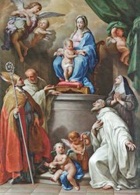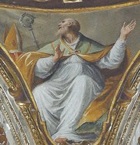


Madonna and Child with venerated members of the Gabrielli family
Altarpiece (ca. 1736) in San Francesco
This altarpiece in San Francesco, which is attributed to Francesco Fernandi, called Imperiali, depicts the Madonna and Child enthroned with four venerated members (supposed or otherwise) of the Gabrielli family. It is based on an altarpiece (1733) by Pompeo Girolamo Batoni in San Gregorio al Celio, Rome, albeit that the cartoon of this original has been reversed. Both of these altarpieces were commissioned by Forte Gabrielli Valletta, who was obviously proud of his holy ancestors.
Three of the four saints described on this page were associated with the Eremo di Fonte Avellana: for the context, see the page on saints from Fonte Avellana.
St Forte Gabrielli (9th or 13th May)
In his “Vite de’ Santi e Beati dell’ Umbria” (1647-61), Ludovico Jacobili writes that St Forte Gabrielli, who was born in Gubbio, belonged to the Gabrielli family. He became a hermit in the mountains near Scheggia before joining the Eremo di Fonte Avellana as a disciple of its founder, the Blessed Ludolphus. He led a life of outstanding sanctity there until his death in 1040, and was then buried in the Duomo. (His relics still survive there under the 6th altar on the left).
His cult was approved for Gubbio in 1756.
St Rudolf and Bl Peter Gabrielli (26th June or 17th October)
According to a late tradition, the widow Rozia Gabrielli and her sons Peter, John and Rudolf donated lands in Camporeggiano to St Peter Damian for a new monastery, which was dedicated as San Bartolomeo. Peter and Rudolf joined the community at Fonte Avellana, while John became prior of San Bartolomeo. While two brothers Rudolf and Peter were documented at Fonte Avellana at this time (see below), and while a monk called John was documented as prior of San Bartolomeo in 1063, their membership of the Gabrielli family is sometimes questioned.
St Rudolf

St Peter Damian wrote the “Vita Sancti Rodulphi Episcopi Eugubini” (BHL 2239), in which he elaborated on the account of the holy life of St Rudolf that he had given in his letter to Alexander II. He extolled St Rudolf’s devotion to prayer and penance and his profound theological knowledge. He underlined that St Rudolf was a prime example of the maxim “quod in eremo didicit, in ecclesia non omisit” (what is learned in the hermitage , do not forget in the church) and thus of the humility and spirituality required of a perfect bishop.
The feast of St Rudolf is celebrated in Gubbio on 17th October, the date of his death, and on 26th June, the date on which the relics were translated to the new Duomo in 1188. Unfortunately, these relics were lost during the restoration of the Duomo in 1670.
(The fresco(1654-8) of St Rudolf illustrated above was painted by Francesco Allegrini in the Cappella del SS Sacramento of the Duomo).
Blessed Peter
The Blessed Peter is documented as Prior of the Eremo di Fonte Avellana in 1059. He is commemorated on the same days as St Rudolf.
Blessed Castora Gabrielli (14th June)
The Blessed Castora (died 1391) was unhappily married to Santuccio Sanfonerio, a lawyer who practiced in Sant’ Angelo in Vado (in the March of Ancona). When her husband died, she became a Franciscan tertiary and gave all her goods to the poor. Her relics are preserved at San Francesco, Sant’ Angelo in Vado.
Read more:
G. Fidanza, “La Pittura del Settecento a Gubbio.: Storia e Documenti”, (2009) Rome
See in particular Chapter 7, “La Pala dell’ Altare delle Terziarie nella Chiesa di San Francesco”
Return to Saints of Gubbio.

